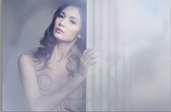Joe’s tale of digital daring and adventure!
Just because it’s a bright and sunny day doesn’t mean you want that same mood for the photographs you’re making.
Those were the kind of thoughts that were running through my mind as I was looking at this photograph of my wife, Mary, and myself standing in front of the splendidly spooky Victorian house featured in the movie Psycho, taken during our private tour of the Universal Studio’s backlot. (Pssssst, that’s “Mother” staring at us out the window in the second floor window.)
The mood here is all too cheery. Not at all becoming for a horror flick set. I decided to change it with Adobe Photoshop CS2, along with some powerful digital power tools, and create a more appropriately eerie image.

It started as a bright and sunny day…
The original photograph of Mary and me was shot by Ralph Nelson, a noted movie set photographer who’s also a heckuva nice guy. Be sure to visit Ralph’s website (www.ralphnelson.com) to view some astonishing work by this talented photographer. For this particular photograph, he borrowed my Pentax Optio S digital point-and-shoot camera. According to the EXIF data, the exposure was 1/800 sec at f/4.3 in automatic mode.

…then, the color was tweaked…
The first thing I do with any digital photograph is to tweak its color, density, and contrast. There are lots of ways to accomplish this, but one of the easiest ways is by using a Photoshop-compatible plug-in such as PhotoTune’s (www.phototune.com) 20/20 Color MD. Using this plug-in is like taking an eye test. The program presents a pair of images and you click the one you like. It doesn’t have to be the “perfect” one, just the best one of that pair. The plug-in uses all of your choices to come up with something much better, and you can even do manual tweaks at the end of the process.

…suddenly, the color mysteriously went away…
When Hitchcock made Psycho, it was a low-budget effort that was shot in black-and-white using the same film crew he worked with on his famed television show, “Alfred Hitchcock Presents.” So, my n step was to convert the color image file into a monochrome photo. My tool of choice for this kind of conversion is The Imaging Factory’s (www.theimagingfactory.com) Convert to B/W Pro Photoshop-compatible plug-in. The plug-in interface provides several options including emulating the tonality of “real” film, so I picked Kodak Tri-X as an obvious choice. Convert to B/W Pro also lets you apply colored filters, add toning, and tweak contrast and brightness based on digital versions of traditional darkroom paper grades.

…day turned to night!
To add a nighttime mood to the photograph, I reached for the Midnight filter that’s part of nik Multimedia Color Efex 2.0 (www.nikmultimedia.com). The complete package includes of a set of Traditional and Stylizing filters, and the Midnight set offers several color tint variations you can choose from depending on your image and taste. For “Joe & Mary go Psycho” I used the standard Midnight filter, but manipulated all of its sliders to get the effect I wanted.
Tip: Don’t be timid when using a plug-in’s slider controls. Push them to the and explore the possibilities rather than just inching them up until you see something you like. Maybe what fits the image best is an or mild application of an effect, but you’ll never know until you try.

Lightning struck!
To give the photograph a little “bam!” seasoning à la Emeril, I decided a lightning strike would be a nice touch. That’s when I selected the Xenofex package of Photoshop-compatible plug-ins from Alien Skin Software (www.alienskin.com.) Xenofex can do more than add Thor’s lighting bolt to your digital images; the package also includes Burnt Edges, Puffy Clouds, Cracks, and lots of other fun effects. Lightning has a large resizable preview screen and Provides controls for the shape and style of the lighting bolt as well as its inner and outer color.
Tip: Although the photograph is in black-and-white, it’s still an RGB file. (Convert to B/W Pro doesn’t change the image file’s Mode to Grayscale.) So I decided to give the lighting a green glow in homage to “The X Files.”

A slashing ending
I did a little digital burning and dodging along with cropping to produce the final photograph that I call “Joe and Mary go Psycho.” I normally don’t like to crop my own photographs, let alone another photographer’s, but cropping out some of the grass in the foreground and that tree branch coming “out of nowhere” in the upper right-hand corner tightened up the image by removing visual data that doesn’t add to the overall impact.
Although I used the Mac OS version of Adobe Photoshop CS2 and all of the plug-ins shown in this example, all of this software is also available for Microsoft Windows. In addition, you can download demo versions of many of the products shown here, and I urge you to give them a try to create your own digital weather effects.
Sometimes, it’s OK to fool Mother Nature…especially when using digital power tools such as the ones shown here.
All content photographs ©2005 Joe Farace

A limited number of copies of Joe Farace’s newest book, “Plug-in Smart” are available at a special price for Adorama Academy students from . Please visit Ralph Nelson and Joe Farace’s new website, www.MovieWalls.com.


